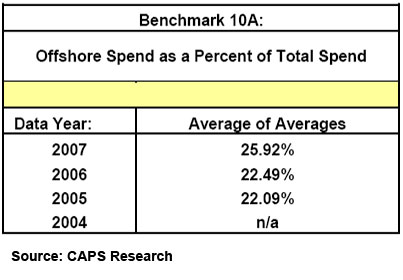| |
|
|
| |
 |
|
| |
|
|
| |
 Sourcing and Procurement Focus:
Our Weekly Feature Article
on Topics of Interest to Sourcing and Procurement
Professionals or Related Supply Chain Functions
Sourcing and Procurement Focus:
Our Weekly Feature Article
on Topics of Interest to Sourcing and Procurement
Professionals or Related Supply Chain Functions
|
|
| |
|
|
| |
|
 |
|
| |
Procurement Overhead Costs Remain Flat for Third Straight Year; $25 million in Average Spend per Procurement Employee
|
|
| |
SCDigest
Editorial Staff
|
SCDigest Says: |
 The drop in spending through e-Auctions is a bit of a surprise, as is the relative lack of e-Procurement activities. The drop in spending through e-Auctions is a bit of a surprise, as is the relative lack of e-Procurement activities.
|
CAPS Research, an arm of the Institute for Supply Management, recently released its cross industry benchmark report on procurement and sourcing, a semi-annual survey of almost 200 companies across a wide range of sectors.
The full report, including industry sector comparisons, is only available to study participants, but CAPS prepares a public report that lists the “averages of the averages” across a wide variety of purchasing metrics.
While industry-specific comparisons are probably of the greatest value, the aggregate metrics are certainly indicative of overall trends, and worth comparing to see how a company stacks up in its procurement management against a broad group of companies and industries.
Key metrics from the report are as follows. The full summary report is available at CAPS Research Summary Report (free registration required).
- The percent of company revenue that is spent through the procurement organization remained steady in 2007 at an average of 45.55%.
- For the third straight year, procurement operating expense as a percent of company revenue remained at .36%, meaning the relative cost of the procurement function itself has neither risen nor fallen during that time.
- The same is true of procurement expense as a percent of total spend, which remained at .83% for the second year, almost the same as the .84% in 2005. There was a large drop that year, however, from the 1.01% procurement overhead cost as a percent of spend in 2004.
- Costs per procurement employee are rising modestly, with an average of $112,470, up less than $2000 from 2006. Those costs include salaries, benefits, and other support/overhead costs, and are meant to be an average of all employees in the procurement organization.
- The average amount of purchasing transaction volume per procurement employee, including administrative staff, averaged just over $25 million in 2007, up about $1.5 million from 2006.
(Sourcing
and Procurement Article - Continued Below)
|
|
| |
|
CATEGORY SPONSOR: SOFTEON |
| |
| |
|
|
|
|
| |
 The procurement organization on average controlled 82.36% of total company outside spend, actually down a little from 2006 but up more than 2% from 2005. The procurement organization on average controlled 82.36% of total company outside spend, actually down a little from 2006 but up more than 2% from 2005.- 27.22% of companies reported they outsourced some procurement activities, basically unchanged from 2006.
- Offshore spend as a percent of total spend rose substantially in 2007, rising to 25.92% of the total versus 22.49% in 2006.
- In 2007, companies on average said they were able to reduce the cost of procured goods by 2.65%, down slightly from 2006. Cost reduction means obtaining a lower price for the same goods or services from one year to the next.
- Procurement consolidation continues, as the percent of suppliers accounting for 80% of total spend continues to decline, down to just 6.26% in 2007 from 6.7% in 2006 and 7.73% in 2004.
- The percent of suppliers being reported as “e-Procurement enabled” rose sharply in 2007 to 19.6%, up from 16.46% in 2006.
- Those numbers track almost exactly the percent of spend made via e-Procurement, which was 19.86% in 2007 versus 17.36% in 2006.
- Perhaps surprisingly, however, the percent of spend that went through e-Auctions declined in 2007 to just 2.58% in 2007, down from 3.18% in 2006.
To the extent that the data are accurate, they in large measure show relatively little improvement in many areas of procurement over the past three years. The drop in spending through e-Auctions is a bit of a surprise, as is the relative lack of e-Procurement activities. If only 6.26% of suppliers constitute 80% of total spend, but only 19.86% of spend is electronically enabled, it says that procurement activities with even large companies are still primarily conducted through traditional means.
What’s your reaction to the CAPS Research summary numbers? Does the drop in e-Auction volume surprise you at all? Are transactions with even large suppliers still mostly driven by non-electronic means? Let us know your thoughts at the Feedback button below. |
|
| |
|
|
 |
 |
 |
| |
|
|
|
|
|
| |
|
|